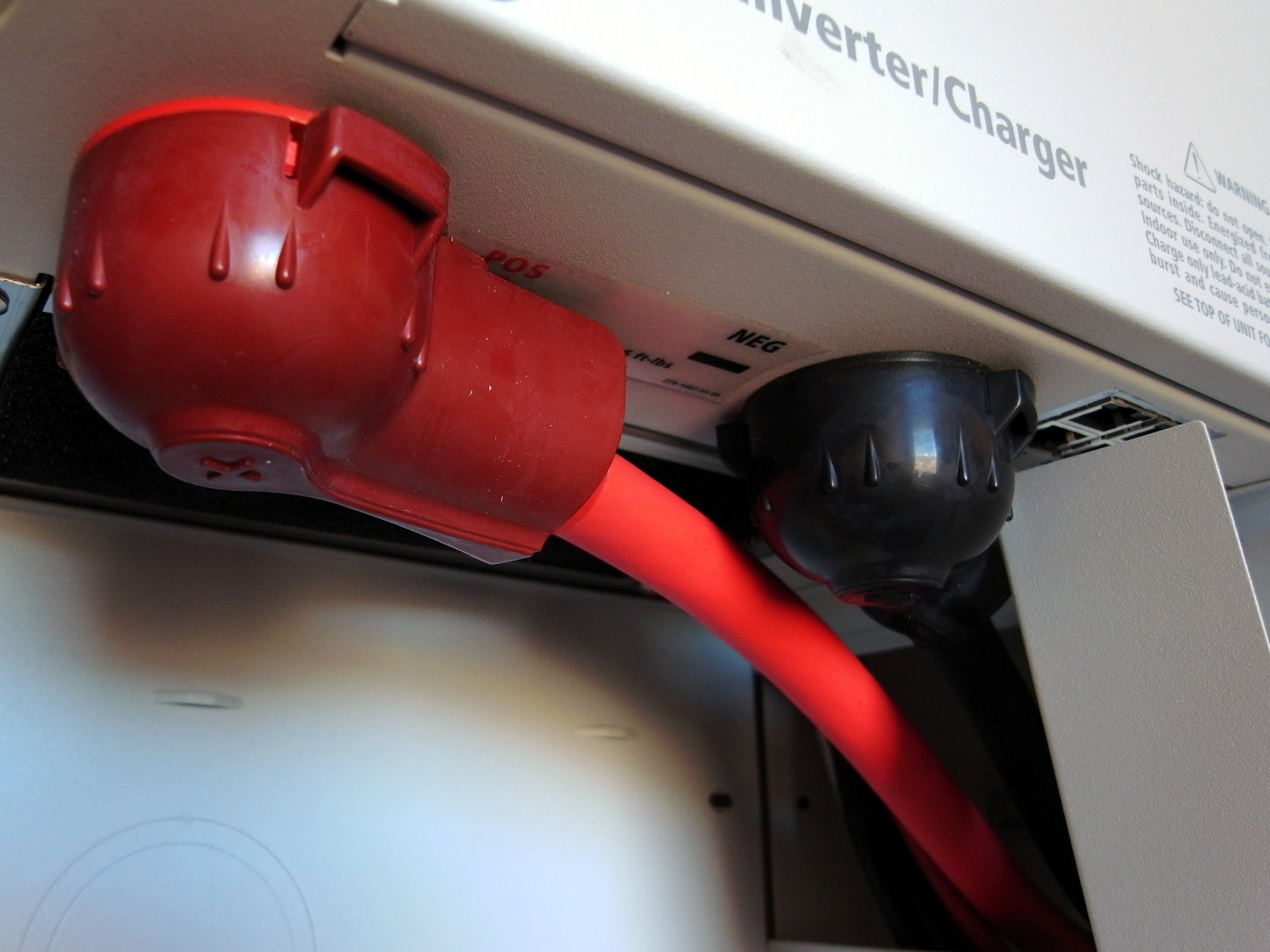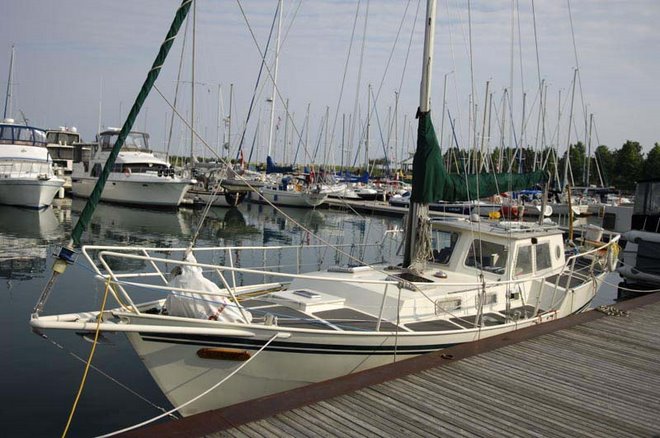 |
| Triple-stitched, reinforced both hither and yon, and a very deep second reef. |
The commissioning process continues: Behold
Alchemy's new main, which I hope will drive our boat in all weathers. Today was not as light air as forecast, but light enough to put on the yankee jib (the poor furling was eventually fixed), the staysail and the main. Mrs.
Alchemy was a huge help, despite the fact that we really need to record the working configuration of all control lines, blocks, beckets and shackles, because we screwed up a few things even a sketch would have avoided.
 |
| The numbers are only close, not exact, because my "trapezoids" do not have parallel bases. |
A note on our logic in going with just two mainsail reefs
Some have questioned our decision just to go with two deep reefs rather than the customary three (or even four). Part of our decision relates to weight aloft, a desire to keep the reefing gear simple, and the simple acknowledgement that our SA/D calculation is "heavy goddamned undercanvased motorsail" (it's about 12.5, if anyone is keeping score); and that we carry full sail longer than many other boats (all things being both equal and tied down properly); and that if we do need reefing, it's going to be a
significant sail reduction, which can be considered a "gear shift" of sorts.
 |
| The boat as built differs slightly; the pilothouse is longer, for one thing. |
The photo above is a reproduction of the original designer's intent and sail plan. The actual boat as built is
somewhat, but not significantly, different. We have no storm trysail at the moment, but we do have a storm staysail. Our idea is that the second reef is deep enough to take us to 50 knots of true wind speed, above which point we are in heave-to, bare poles plus storm staysail, or put out a drogue territory. The choice of
heaving to versus running off is situational, of course, and
there's strong cases for both in variable circumstances. Preparation, however, is key, and that includes the crew with the correct clothing, adequate rest, the proper safety gear and the proper preparation of the boat in terms of lashings and stowage. I've been in some heavy weather when gear has come loose, and it's no joke to be the person who keeps a flogging solar panel from going into the Atlantic.
Alchemy, being a heavy displacement full-keeler, is intrinsically sea-kindly in a blow (bar bad stowage or bad seamanship) but if we have enough information about the "storm track" of whatever storm track the gale we happen to be in, and land isn't nearby,
running off is also a sound tactic.
The photo the new main with the numbers represents a rough (because my sail areas are off a bit, due to non-parallel bases of the trapezoids comprising the sail area reductions of each reef) estimate of how much sail area reduction, and thus sail power applied, there is to each reef. The actual first reef sail reduction is about 35% and the second reef is about 67% of the total main area, which are ratios I devised with the sailmaker as matching our goals. I estimate is about 305 square feet for the old main and about 330 square feet for the new one picture. It's not hard to factor in the sail gained by the extra roach and fractionally higher hoist and foot dimensions of the new main, but it's not strictly necessary to calculate, either; this main is heavier, but bigger: performance in light air should be a wash, whereas it has been built to withstand higher true wind speeds better. As experienced passagemakers Beth Leonard and Evans Starzinger note,
the amount of time spent in truly windy weather can be quite low, and the tools to avoid it at sea have improved greatly in the last 25 years.
I'm not sure if I've mentioned it before, but the current sail inventory consists of
- light air main (spare; stowed)
- heavy air main (on the main)
- Yankee top jib (rigged on the forestay furler)
- light air genoa (spare, stowed)
- Cruising assymmetrical chute (stowed)
- Staysail (bagged, hanked on)
- Storm staysail (stowed, hank on)
If some deficiences in the sail inventory are noted, we will remedy them. Frankly, we need more real-world operation to determine that.
 |
| Vang always sounded villainous to me. |
Prior to the initial Big Hoist, however, came some prep and untangling and sorting of the many halyards and lifts descending from the mast. Shrouds were further tightened, cotter pins and rings were pocketed, as we the usual tools. Oh, yeah, and I had to put the boom on. Some innovations this season include a triple-block vang and some upgrades in the shackle department, thanks to a providential Craigslist score some time back.
 |
| Wichard gear: Choose it even for unconvential uses. |
Being a largely self-taught sailor, save for those RYA adventures, I have been known to use boat gear in non-standard ways. I needed a way to fix the topping lift to the boom. The conventional way, I'm guessing, would be to add a second
bail to the one below the boom leading to the mainsheet. I like the idea of the topping lift being quickly detachable, and I had a Wichard tether shackle in my Box o' Parts, and so here we are. Given that the topping lift line is 6 mm Dyneema core and the shackle can bear two tonnes of weight, I have no doubt lifting COBs and, more mundanely, general cargo and tenders aboard with this setup will be straightforward with some sort of preventer or similar belaying line to control swing. I think I should, however,
get a compression tube over that through-bolt prior to any such antics.
 |
| The staysail in the anchor well. We generally leave it rigged and ready to go in its bag, like a spinnaker. |
We were pleased with the tabernacle steps. They enabled me to stand comfortably to secure shackles to the main's headboard and, later, to bungee halyards to keep them from slapping: this action makes you friends on the docks. We've determined that a third, "mini" step on the starboard side of the tabernacle will allow Mrs.
Alchemy, who is somewhat vertically challenged, to reach the top of the mainsail cover in order to tie it off and zip it. There's also some talk of a belt arrangement to free up both hands while four feet off the hard, metal deck.
 |
| Battenless, a sail's more like a tarpaulin. A four-grand tarpaulin. |
The Tides Marine track, plus the batten slides and SS slugs, worked very well on the initial, battenless hoist. We wanted to check the dimensions before doing that somewhat tricky operation (the wind had picked up). We were gratified to see that the hoist height was just about perfect and that the new main made use of some space previously filled by air at its trailing edge with
roach.
As mentioned previously, this is an attempt to get just a little more sail area in play to drive us in lighter air a little more effectively. We will test that theory this summer,
which is evidently going to be stormy.
 |
| More or less flattened, and the roach favours the lower portion of the main for drive. |
 |
| Battens in and fully hoisted. |
The two reefs are unrigged for the moment, as I want to ponder the best lines for the job. I also need to get a
tack hook and other bits and pieces, although much of this can be improvised with light lines.
 |
| Battens battered in. |
The new main is old school. There's really nothing on its nine-ounce Dacron surface that wouldn't have been (save for the "system" of the slippery external track) on a cruising main 25 years ago. We chose that because we need to be able to do our own repairs and because we are realistic about the go-fast potential of
Alchemy: There isn't any. We need a strong sail to keep hoisted to capture the wind to make us go; with many boats, the sails are very light, very strong and very expensive. Ours is a different path in which some compromises in the absolutely most appropriate material (some sort of rugged and four times the price composite material, I'm guessing) is not selected in favour of ease of owner repair, durability of known quantities, and the very good fact that this is not a go-fast boat and never will be. It's an "arrive alive" boat. This is the sort of sail we want for that goal.
 |
| These sewn-in fabric bands spread out the shearing forces on the sail's corners; in this case, the clew. |
I was pleased with what I saw today and we are pretty sure the fit is close to exact out of the (literal) bag. Of course, looks aren't everything: a few challenging sails will tell us this vital piece of equipment's true value.
 |
| The old mainsail cover simply won't do. |
It didn't take look, however, to confirm what we and our sailmaker had already anticipated: the heavier sail material and the stacking slugs of the Tides Marine system make for a physically larger pile on the boom top. We'll need a new sail cover, and soon. This needs to last us for many years and thousands of miles.
 |
| And this is why: the old one has been outgrown. |




























































